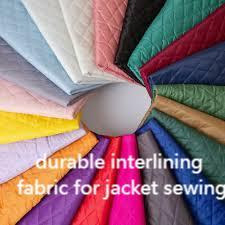In contemporary apparel production, the role of Interlining is easy to overlook, yet the choice of that layer directly affects how a garment drapes and endures; designers who specify the right Interlining early avoid costly rework and achieve consistent finished results. This article explores material selection, bonding methods, production best practices, care guidance, and sustainability strategies so manufacturers and brands can make informed decisions that balance aesthetics, function, and lifecycle cost.
Matching Support to Fabric and Purpose
Selecting the correct internal support begins with understanding how it interacts with the outer textile. Lightweight sheers require soft, flexible backing that preserves fluid movement, while structured suiting benefits from firmer bodies that maintain lapels and collars. Consider stitch penetration and seam bulk: some supports compress more under needle pressure, altering the final silhouette. Running small-scale prototypes reveals how combinations behave, helping teams choose materials that complement the intended hand and motion of the garment.
Bonding Methods and Process Control
There are two primary attachment strategies: mechanical sewing and heat-activated bonding. Fusible options speed assembly by eliminating extra stitch lines, but they demand precise control of temperature, pressure, and dwell time to avoid surface shine, stiffness, or puckering. Non-fusible alternatives require additional sewing but often produce a softer, more natural finish. Aligning the chosen method with existing production equipment, operator skill sets, and throughput goals prevents bottlenecks and maintains quality across batches.
Durability, Care Labels, and Customer Experience
The inner support determines how a garment ages. Materials that retain adhesion through repeated laundering and resist shrinkage extend wearable life and reduce returns. It’s essential to provide clear care guidance—specifying safe wash cycles, ironing temperatures, and recommended professional cleaning when necessary—to preserve both appearance and bond integrity. Including these instructions on labels improves customer satisfaction and lowers post-sale service demands.
Sustainability and Material Innovation
Environmental priorities are reshaping material choices across the supply chain. Newer supports incorporate recycled fibers, bio-based polymers, and low-energy adhesives that reduce production footprint without sacrificing performance. Reducing waste through optimized cutting layouts and repurposing offcuts also contributes to sustainability goals. Evaluating materials by lifecycle impact—considering durability and end-of-life recyclability in addition to upfront cost—helps brands meet regulatory expectations and consumer demands for responsible products.
Quality Assurance and Supplier Collaboration
Consistent results rely on documented process parameters and strong collaboration with material suppliers. Standardize pressing temperatures, dwell times, and handling protocols to reduce variability. Routine peel strength and wash-fastness tests catch issues early, preventing widespread defects. Sharing technical fabrics and production details with suppliers enables tailored solutions and accelerates troubleshooting. Maintain traceable records of batches, test outcomes, and supplier certifications to simplify audits and support continuous improvement.
Design Strategies for Complex Assemblies
For garments that combine multiple textiles or delicate trims, strategic placement of internal support is crucial. Localized reinforcement—firmer layers at collars and lighter backing in facings—balances structure with comfort. For stretch garments, select supports with compatible elongation properties to avoid restricting movement. Advances in digital cutting and laser patterning allow precise placement that minimizes visible bulk and improves aesthetic outcomes, enabling designers to pursue complex silhouettes without compromising wearability.
The Road Ahead: Multifunctional and Smart Layers
Emerging materials are adding functions beyond structure—thermal regulation, moisture management, and even pathways for conductive elements used in wearable technology. Such multifunctional layers must balance mechanical support with additional requirements like insulation and electrical insulation. Investment in R&D and pilot projects will open opportunities for garments that combine traditional tailoring standards with contemporary functionality.
Thoughtful selection, precise process control, rigorous testing, and robust supplier partnerships turn the unseen layer inside a garment into a strategic advantage. For a comprehensive technical overview and application guide, visit https://www.interlining-factory.com/news/what-is-interlining-types-applications-and-more.html
 Free IL
Free IL


